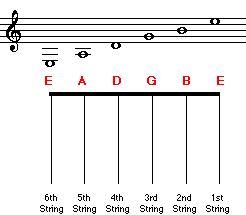Guitar

With the guitar, you have six strings, which correspond to six different pitches.

The guitar strings are numbered 1-6 with 6 being the low E and 1 being the high E.
One interesting challenge about the guitar is that there is more than one way to produce any given pitch. The guitar has frets, which are the ridges that section off the neck of the guitar. Each fret represents one half step. So if the lowest string on the guitar is E, holding down the first fret on that string will produce an F. The next fret will produce an F-sharp / G-flat, and the third fret will produce a G.
Here is a chart that shows the note names on the guitar fretboard:

So, for example, you could play this note  using the first string (open), or you could play it with the second string by holding down the 5th fret, or with the third string by holding down the 9th fret (not shown). In order to eliminate any ambiguity, guitar notation will sometimes use numbers to indicate which fret to use, which in turn tells you on which string the note must be played. For example:
using the first string (open), or you could play it with the second string by holding down the 5th fret, or with the third string by holding down the 9th fret (not shown). In order to eliminate any ambiguity, guitar notation will sometimes use numbers to indicate which fret to use, which in turn tells you on which string the note must be played. For example:

By studying the above passage, you will see that the first seven notes (E, F and G) are played on the first string (open, 1st fret, 3rd fret), whereas the next four notes (C and D) are played on the second string (1st and 3rd frets).
Guitar music may also be notated in tablature. Guitar tablature uses a staff of six lines, which represent each of the six strings on the guitar, rather than note names. Numbers are used, as shown in the example above, to indicate which fret to use. Consider the passage above notated in tablature:

Tablature usually occurs in conjunction with standard notation. When this is the case, rhythmic indications (such as the note stems, and the dot on the dotted quarter note) may be omitted from the tablature, because these are clearly indicated by the standard notation.
Note: Guitar music is written one octave higher than it sounds.